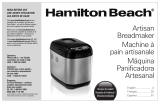UK Helpline 0844 871 0944 Replacement Parts 0844 873 0710 Ireland Helpline 1800 409 119
6
About This
Breadmaker
• It has three settings to make a
small 450g (1lb,) medium 680g
(1.5lb) or large 907g (2lb) loaf. N.B.
Weights are approximate and
depend on recipe.
• A Fruit and Nut beep signals when
extra ingredients can be added so
they don’t get chopped by the
kneading blade. See page 12.
Kneading Blade
• Clean the blade every time after
use, ensure the blade rotates freely
on the spindle before each use,
you can add a little sunflower oil to
the rotating shaft before putting it
back into the pan. This will then be
ready for next use.
Programme Number
Descriptions
1 Basic white and brown (2:51 -
3:00) For white and brown bread.
Also for flavoured breads with
added herbs and raisins.
2 Wholewheat (3:32 - 3:40)
For the baking of bread containing
significant amounts of wholewheat.
This setting has a longer preheat
time to allow the grain to soak up
the water and expand. It is not
advised to use the delay timer as
this can produce poor results.
3 Sweet (2:35 - 2:45)
For the baking of sweet type bread
which gives a crisper crust than on
basic setting. The crisper crust is
produced by the sugar
caramelising.
4 Sandwich (2:55 - 3:00)
This is to bake light texture bread
but with a softer and thicker crust.
5 French (3:30 - 3:50)
For the baking of light weight bread
such as French bread which has a
crisper crust and light texture.
6 Dough (1:30)
This setting only makes the dough
and will not bake the bread.
Remove the dough and shape it to
make bread rolls, pizza, etc. Any
dough can be prepared on this
setting. Do not exceed 1kg (2lb) of
combined ingredients.
7 Jam (1:20)
Use this setting for making jam
from fresh fruits and marmalade.
Do not increase the quantity or
allow the recipe to boil over the
pan into the baking chamber.
Should this happen, stop the
machine immediately. Remove the
pan carefully, allow to cool a little
and clean thoroughly.
8 Bread mixes (2:30)
For preparation of approximately a
1lb loaf, using a packet of shop
bought bread mix. These mixes
usually come in two varieties: ‘Just
add water’ and ‘Just add flour and
water’.
9 Speciality (2:50)
The bread baked on this setting is
usually smaller with a more moist
and dense texture. These breads
do not use bread flour.
10 Gluten Free (2:35)
Gluten free breads are yeast
leavened breads where gluten (a
protein part of the wheat / oats /
barley / rye) is removed. People
who cannot tolerate gluten in their
diet (known as Coeliacs), can
obtain gluten free flour on
prescription. It is found in most
high street chemists and health
food stores but can be expensive.
11 Fastbake I (1:10)
For preparation of a 1.5lb white loaf
in a reduced time period. Loaves
made on this setting can be
shorter and the texture more moist.
12 Fastbake II (1:15)
For preparation of a 2lb white loaf
in a reduced time period. Loaves
made on this setting can be
shorter and the texture more moist.
13 Extra bake (1:00)
This setting is bake only and can
be used to increase the baking
time on selected settings. This is
especially useful to help ‘set’ jams
and marmalade. When started the
default time is 1 hour (1:00)
minimum and counts down in 10
minute intervals. You will have to
manually switch this off by pressing
the start /stop button, when you
have completed the Extra bake
process. It is advised that you
check the condition of the bread or
jam after 10 minutes and at 10
minute intervals. Pressing +
increases the time in increments of
10 minutes. When selecting Extra
bake straight after another
programme, if the message H:HH
is displayed, open the lid, remove
the pan and allow to cool for 10
minutes. When cool, replace the
baking pan and its contents, set
programme and press start.
14 Pizza dough* (0:50)
This setting can be used to mix
plain or flavoured pizza dough, as
well as fresh pasta dough. Once
the programme is complete, the
dough can be removed from the
machine and shaped into pizza
bases to be cooked in the oven, or
cut into pasta to be boiled.
15 Quick* (1:40)
For white bread that is required in a
shorter time. Bread baked on this
setting is usually smaller with a
dense texture.
16 Cake* (1:10)
Your Morphy Richards breadmaker
can also be used to bake a
selection of cakes. The process is
as simple as making bread; just
follow the recipes provided on
pages 22 and 24. Alternatively you
can also use the machine to make
cakes from a cake mix where all
you need to do is add water. In this
instance, you should ensure the
mixture is combined with the water
before adding it to the machine.
17 Dessert* (2:50)
This setting allows you to make
other desserts as well as cakes in
your breadmaker. The process is
again straightforward and simple;
just follow the recipes carefully on
page 25.
*Only available on 48323 model
Before First Use
Before first use, please take a few
minutes to read this instruction
book and to find a place to keep it
handy for reference. Pay particular
attention to the safety instructions.
1 Carefully unpack the breadmaker
and remove all packaging
materials.
2 Remove any dust that may have
accumulated during packing.
3 Wipe the outside surface of the
breadmaker with a clean, damp
cloth. Wash the baking pan and
kneading blade (see care and
cleaning on page 8).





















